Kawa poplar timber - properties and market opportunities
Acknowledgements: Many thanks to the MPI Hill Country Erosion Programme for supporting Northland Regional Council to achieve improved soil conservation outcomes and build our technical capacity.
Methods
Kawa poplar was logged from a small 28-year-old pruned stand of trees near Titoki, Northland, owned by Peter Davies-Colley. Logs were transported to Kerikeri and sawn by Li legler after segregating into post logs and logs for producing sawn timber. Sawn timber conversion and grade recoveries were quantified. The timber was then used for a range of tests and products to determine the suitability of Kawa poplar for specific applications, described below.
Kawa poplar stand and logging
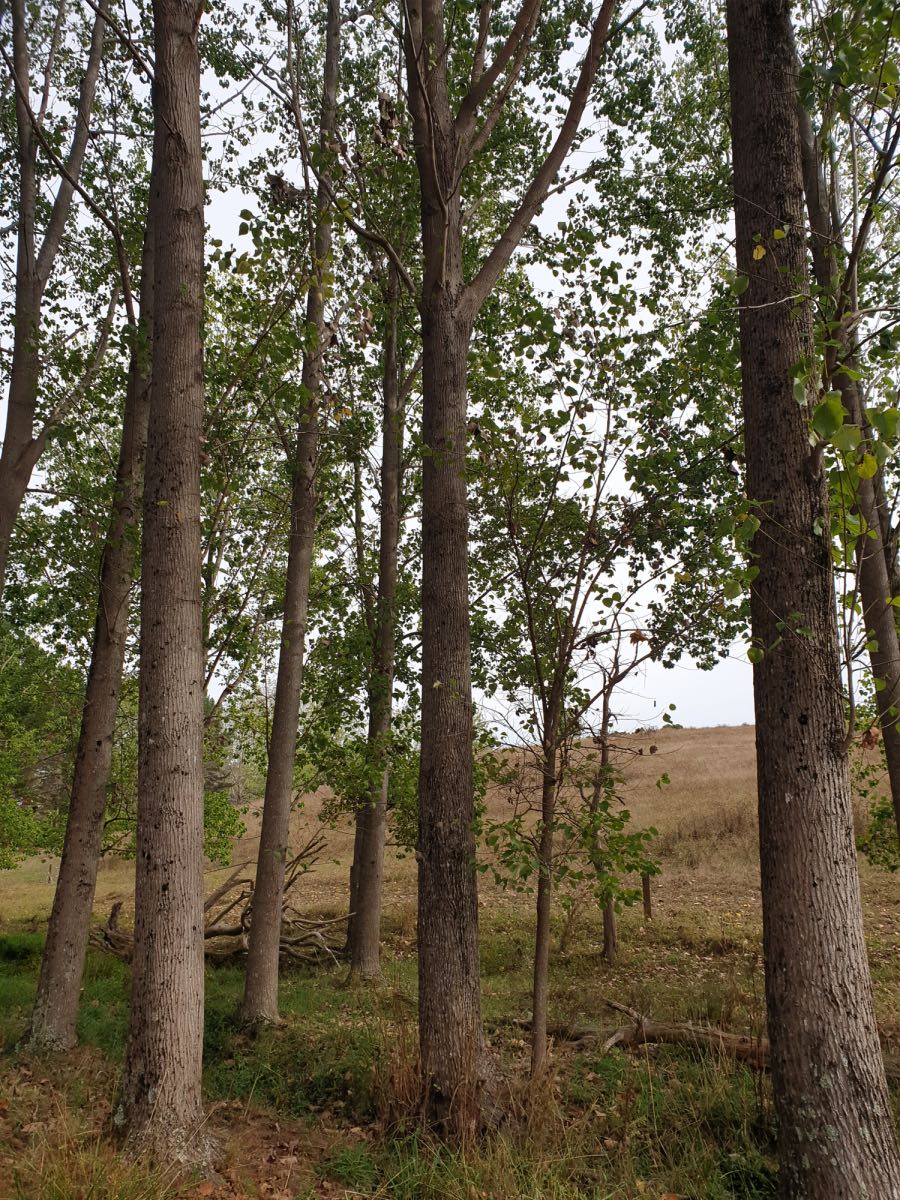
Some of the Kawa poplar trees before harvesting.
Seventeen pruned Kawa poplar trees were harvested from a small 28-year-old stand growing near Titoki, Northland. The trees were growing on a reasonably sheltered pastoral hill country site, on a moderately fertile clay loam soil. Trees were harvested mechanically, and 71 logs were cut to length on site, with the bark and limbs removed mechanically.
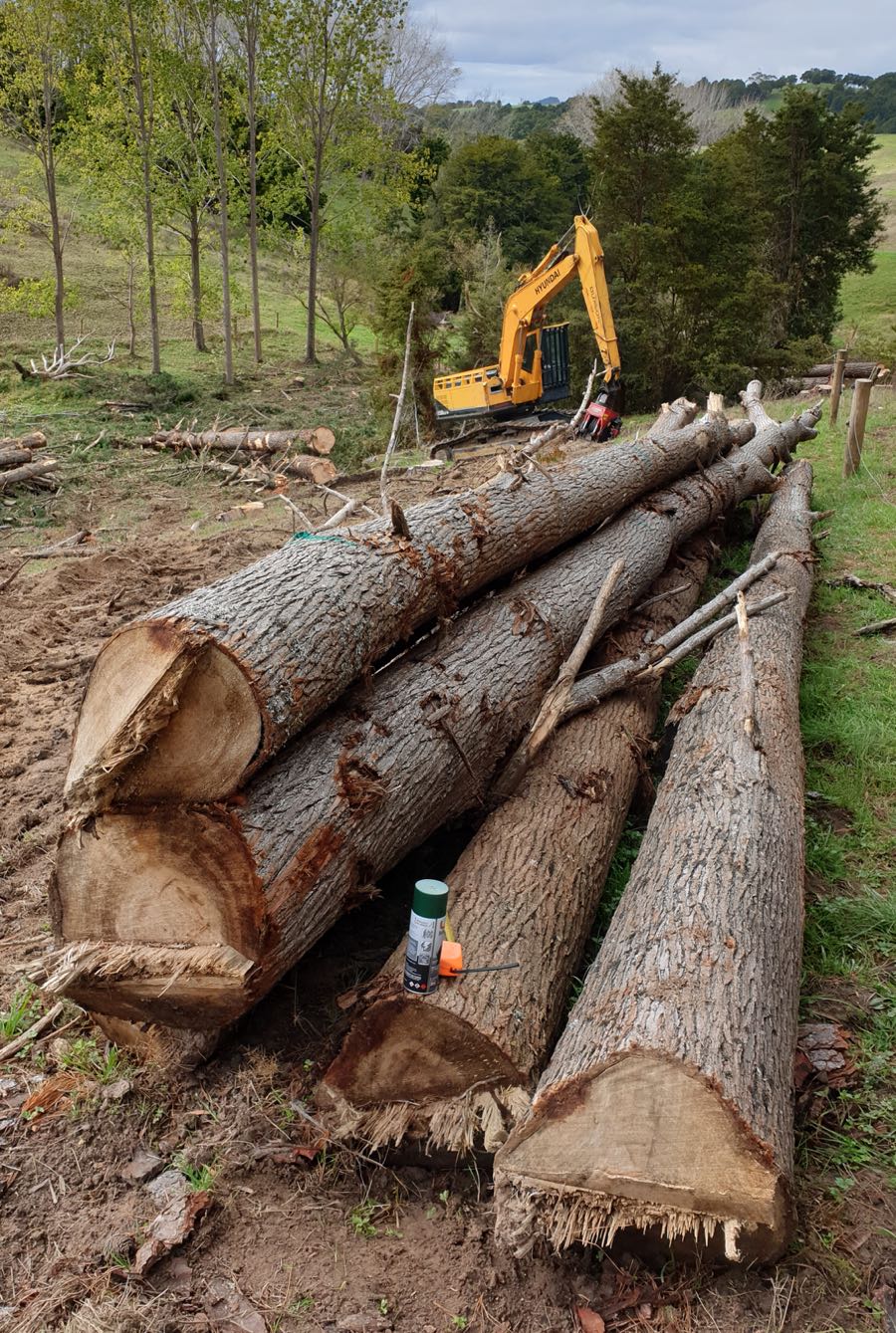
Tree diameter under bark and heartwood diameter were measured for both the large end and the small end of all logs. Logs were identified according to tree and log position, then segregated into sawlogs and post logs, according to log shape and log diameter. Excessively serpentine logs and small logs were allocated to postwood. Only logs greater than 18cm diameter were milled into boards.
Heartwood content was calculated as heartwood diameter squared divided by diameter under bark squared for each height position measured in each tree.
Sawn timber preparation
Forty-three logs from fifteen trees were milled two weeks after harvest. Sawlog length was 3.7m. Small end diameters ranged from 18cm up to 44.5cm, with a mean small end diameter (SED) of 30.6cm. Heartwood diameters ranged from 7cm up to 40cm, with a mean of 20.2cm.
Sawlogs were sawn on a Wood-Mizer 3mm kerf horizontal bandsaw into 25mm and 50mm slabs.
These slabs were then edged using a Wood-Mizer twin-blade edger. Wider central slabs were ripped through the centre of their width into two slabs, before edging into straight boards, avoiding inclusion of pith in the boards. Edging involved visual judgment calls that focused on grade recoveries in preference to volume recoveries. Resulting nominal board widths were 75mm, 100mm, 150mm, 200mm, 250mm and 300mm. Nominal board thicknesses were 25mm and 50mm. Boards were oversized during sawing to allow for shrinkage during drying.
Individual log volumes were calculated from data on their large and small-end diameters and length using Smalian’s formula. Sawn recoveries were calculated from nominal board dimensions, but excluded those sections containing taper and wane. The nominal volumes of the individual boards cut from each log were summed to give the total sawn timber recovery per log. These values were divided by log volume to give the proportional recovery.
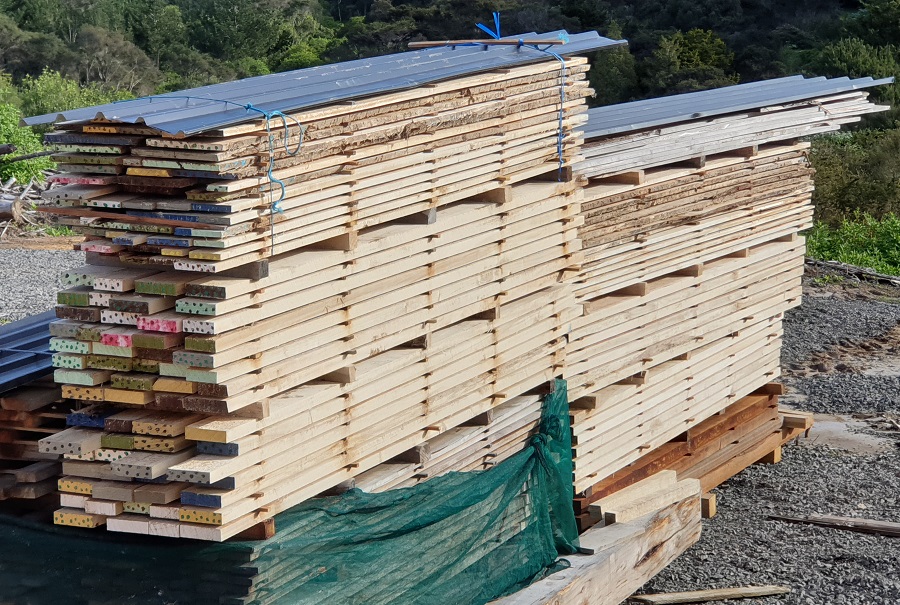
Sawn timber air drying.
After air drying outdoors under cover for eight months, boards were visually graded as either “clears”, “cladding” or “structural”. Two grading methods were used. The first targeted clearwood lengths (“best grade”) and the second targeted longest graded lengths in preference to shorter lengths of a higher grade (“long length grade”). Criteria for the three grades are described in Table 1 (criteria for higher grades always exceeds those for lower grades).
Lengths of defect were marked as if docked and allocated to one of the following categories: knots; pruning wounds; end-splits; pith; excessive crook and excessive bow. Lengths of end splits were measured from the end of the board to where the visible crack ended. Knots were further categorised as follows:
- knot (only classified as defect according to the grade allocated)
- large knot defect
- spike knot (only classified as defect according to the grade allocated)
- large spike knot defect
- pruning wound (only classified as defect according to the grade allocated); and
- large pruning wound defect.
The presence of pith was recorded as a defect (noting that edging actively avoided inclusion of pith in boards). Crook and bow were also recorded as defects where these exceeded the limits given in NZS 3631:1988 (Standards New Zealand 1988).
| Grade | Criteria |
|---|---|
| Clears | Clearwood on the front face and edges, with the board also meeting the requirements of Cladding grade. |
| Cladding | Dressing grade as per NZS 3631:1988 (Standards New Zealand 1988) with two additional requirements for cladding from NZS 3602:2003 (Standards New Zealand 2003a):
|
| Structural | No. 1 framing grade as per NZS 3631:1988. |
Detailed methods of timber preparation are described in Satchell and Moore (2023).
Some grading photographs are available here »
Posts
The post logs were either sawn into quarter round posts, or cut to length for round strainers or posts. Twenty-seven sawlogs were identified as appropriate for quartering into posts. These were cut to length and were quartered on the bandsaw through the pith. Most post logs were quartered at full length (3.7m), then each quarter was cut in half with a chainsaw into two 1.85m posts. Where excessively serpentine, logs were cut into 1.8m lengths and then quartered on the bandsaw. Logs with a small end diameter less than 16cm were not quartered because these have insufficient diameter to produce the target minimum #2 post. Target products were:
- #1 round strainer (2.4m long)
- #2 round strainer (2.4m long)
- #1 quarter-round post (1.8m long)
- #2 quarter-round post (1.8m long)
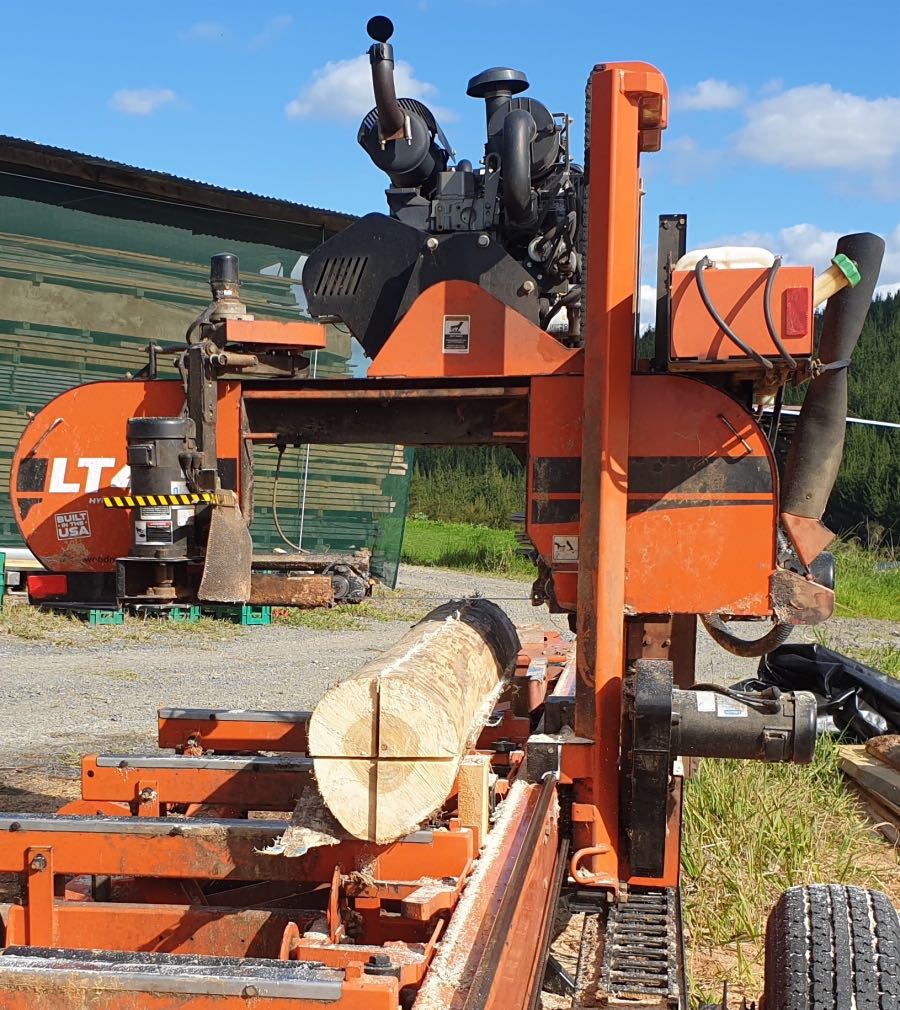
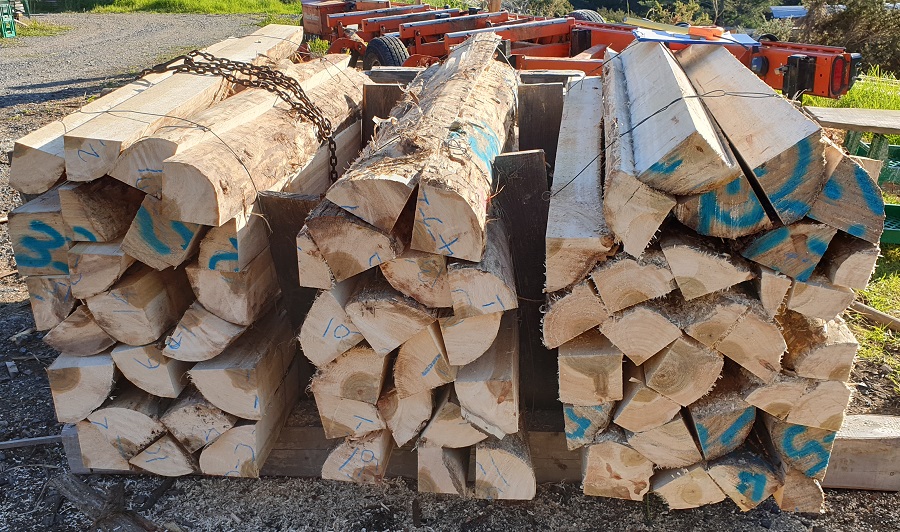
Freshly sawn quarter-round posts showing low levels of heartwood.
Posts - preservative treatment
The quarter-round posts, round posts and strainers were transported to Mt Pokaka Timber Products and CCA preservative treated to the H4 Hazard Class by adding the poplar posts to a batch of radiata pine being treated.
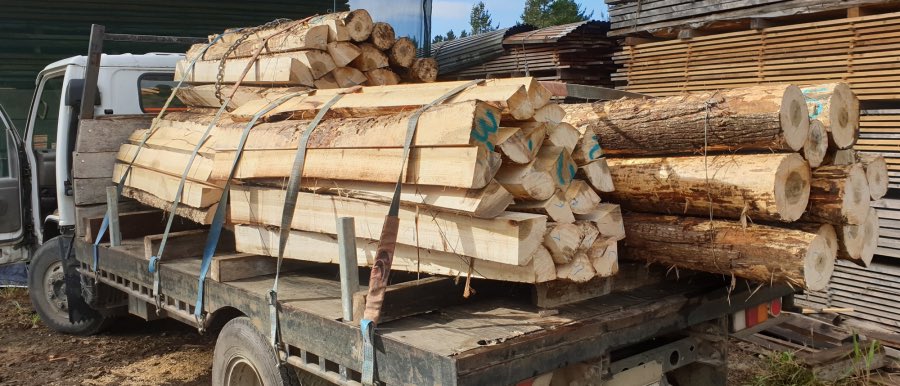
Quarter-round posts and round strainers ready for delivery to treatment plant.
Posts were chrome copper arsenic (CCA) H4 preservative treated after steam preconditioning at Mt Pokaka Timber Products, Kerikeri. Trees were felled one month prior to treatment and were treated 9 days after sawmilling. Strainers were steamed for 7 hours and posts were steamed for 5 hours. Posts and strainers were then held for 36 hours before CCA pressure treatment to H4 in the same treatment vessel. CCA solution strength was 1.8% at the start and 273 litres were pressure impregnated over ten cycles of alternating pressure method (APM) treatment, with pressure of up to 1350 kPa for two minutes, then released for one minute.
Treated posts were dried under cover for 6 months before storing outside in the weather. Installation as a farm fence took place in December 2022.
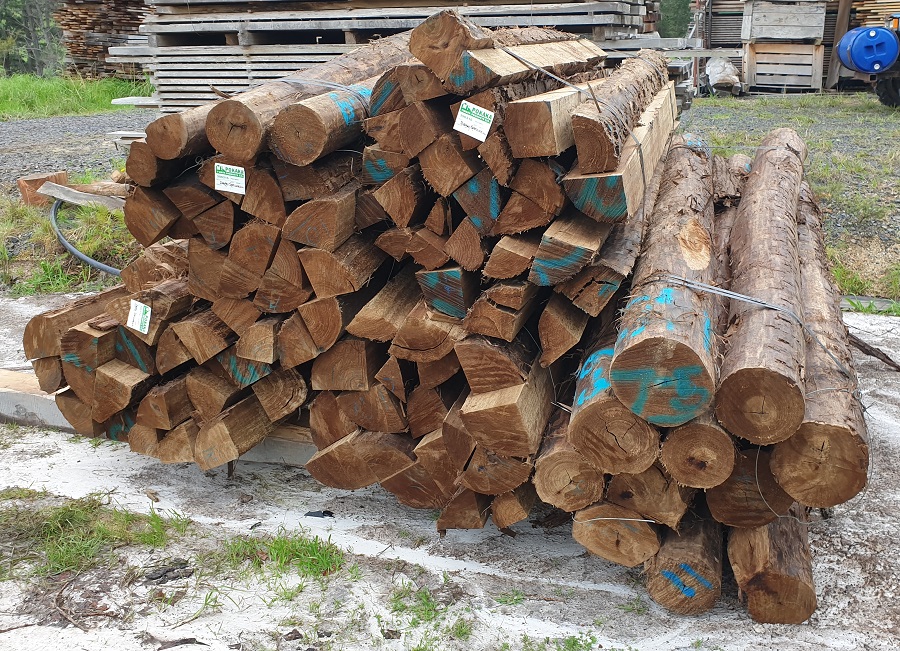
CCA treated posts and strainers ready for preservative penetration and retention testing
Posts - H4 preservative testing
Chrome Copper Arsenic (CCA) retention and penetration tests were conducted by Independent Verification Services Ltd, Hamilton. 30cm length samples were cut from the middle of each post being tested. These were tested for heartwood/sapwood using the VBRT test with ammonia buffer as per AS/NZS 1605.1 2018, followed by H4 CCA retention analysis and penetration spot test as per NZS 3640:2003.
Two control samples were submitted as 30cm lengths cut from a single round radiata pine post, supplied from the treatment batch the Kawa was included in.
Two round Kawa poplar posts of a similar size to the radiata control post were also tested, along with two larger Kawa strainer posts and four quarter round Kawa posts.
The Kawa posts were tested for sapwood content, with retention analysis on what was assumed to be sapwood.
In addition, fifteen 30cm samples prepared from the middle of fifteen 95mm x 70mm sawn poplar posts were provided for testing by Ian Wilson, Waikato. These posts were produced by sawing square posts from poplar of unknown cultivars, air-drying the posts, followed by batch H4 treatment by Les O'Leary of Tokoroa. The samples were tested for full cross-section H4 CCA retention, i.e. no heartwood removal - the entire wafer was milled and the samples were treated as 100% sapwood.
Retention Analysis - Nitric Acid Micro digestion, 100°C for 60 minutes as per AWPA A7-12 (modified). Arsenic, chrome and copper were detected using Nitric Acid Digestion, ICP-OES analysis, correction for Moisture. as per AS/NZS 1605.3:2018 (Modified), AWPA A21-08 (Modified). Total active elements (TAE) were calculated as Copper + Chromium + Arsenic.
Penetration spot test - Rubeanic Acid test as per AS/NZS 1605.2 2018
Strength, stiffness and density properties testing
All Characteristic bending strength and stiffness testing was undertaken using a Grade 1 Baldwin Universal test machine at Scion's timber engineering laboratory. Testing for bending strength and stiffness as a joist (on edge) was undertaken in accordance with AS/NZS4063.1:2010 & AS/NZS4063.2:2010 over a span to depth ratio of equal to 18:1. The test pieces were tested in their dry gauged state. The values calculated were used to assign the timber to a strength class according to NZS3603:1993.
Subsequent to the bending test, a short cross section was cut from an undamaged clear wood section of each specimen close to the failure point, for density and moisture content determination. Moisture content was measured using the oven drying method. Nominal density was calculated for each section from the oven dry weight over volume at test. Density at test was calculated for each section from the test weight over volume at test.
Characteristic stress values for Kawa poplar solid timber
Stiffness, strength and density testing was undertaken on 31 randomly selected structural graded boards (2m length, 90mm x 45mm cross section), dry and planar gauged, No. 1 framing grade (as per NZS 3631:1988).
Methods of preparation and testing are described in detail in Satchell and Moore (2023).
Characteristic stress values for glulam Kawa poplar
Stiffness and bending strength testing were undertaken on 32 glulam beams. Sawn Kawa poplar was supplied to Tauranga-based glulam manufacturers Laminated Beams Ltd, as 100mm x 25mm random-length timber. This was crosscut into clearwood shooks and finger-jointed using 4mm structural finger joints bonded with melamine urea-formaldehyde (MUF) adhesive. The finger-jointed lengths were dressed to 20mm thick, and the test beams were glued as 4 laminates to 80mm depth with melamine urea-formaldehyde (MUF) adhesive. The glulam was then crosscut to the 1.5m lengths and ripped in two, then dressed to 45mm wide to produce the thirty-two 80x45 glulam beams. Wood moisture content at gluing was measured at 13%.
MUF resin was chosen because it dries clear so is suitable for appearance applications and is commonly used for interior glulam products.
The number of finger-joints per test beam ranged from 1 to 5. See Scions report here ».
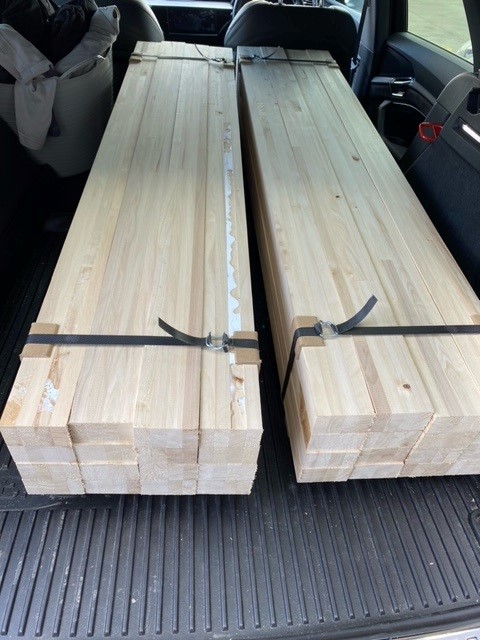
Glulam test beams being delivered to Scion for testing.
Characteristic stress values for thermally modified Kawa poplar
Stiffness, strength and density testing was undertaken on 31 structural graded boards (2m length, 90mm x 45mm cross section), planar gauged, No. 1 framing grade (as per NZS 3631:1988). The wood was thermally modified to 230° (Thermowood 230 schedule).
Small clears testing
Stiffness and strength testing was also undertaken on 140 small defect-free specimens (500mm length, 25mm x 25mm cross-section). The small clear specimens were ripped from two radial positions (inner/outer) at up to five height positions, from seven trees, to assess within-tree and between-tree variation in these properties. The first vertical height position was at 1.85 m +/- 1 m and then at 3.7 m increments +/- 1 m up the stem. Two or three replicates were tested for each radial position and height position within each tree. Specimens were conditioned at 20°C and 65% RH until they achieved constant mass (approximate equilibrium moisture content of 12%). Bending tests were conducted using an Instron universal testing machine at Scion, Rotorua. The growth rings were aligned as much as possible with the direction of loading, in accordance with ASTM D143-94 (American Society for Testing and Materials 2000). The test span was 280 mm with a centre point load. From the load-deflection data the fibre stress at the proportional limit (FSPL), fibre stress at maximum load (modulus of rupture) and modulus of elasticity were calculated. Following testing, each entire specimen was used for determination of density and moisture content. Moisture content was measured using the oven drying method. Oven-dry density (a proxy for basic density) was calculated for each test specimen from the oven dry weight and volume measured at the time of testing. Density at the time of testing was calculated for each test specimen from the weight and volume at the time of testing.
Methods of preparation and testing are described in detail in Satchell and Moore (2023).
Boron treatment of structural timber
Two methods were trialled for boron diffusion treatment:
- water-based boron diffusion; and
- Monoethanolamine-based boron diffusion.
Both methods were tested for boron retention and penetration, along with durability performance (framing test).
1. Water-based boron diffusion
A boron solution was prepared by adding 2.3 kg of granular boric acid (Orthoboric acid 99.99% H3BO3) and 3 kg of borax pentahydrate (disodium tetraborate pentahydrate Na2B4O7.5H2O) per 10 litres of water. The solution was gently heated and stirred until the salts dissolved and no visible solids remained, then used before any crystallisation occurred in the solution. Rough-sawn freshly milled boards with cross-sectional dimensions of 100 mm x 50 mm and 150 mm x 50 mm were immersed in the solution for five seconds, then block stacked and fully wrapped with a black polythene cover and stored outdoors for 41 days to allow the boron to diffuse into the wood. Boards were then filleted and air dried for eight months. Sixteen samples were prepared for analysis by machining to 90 mm x 45 mm and then cross-cutting a single 20 cm length that contained defect-free wood, no closer than 50 cm from board ends. Boron retention and penetration tests were conducted by Independent Verification Services Ltd in Hamilton. Analysis was based on total cross section retention and penetration, because tests were unsuccessful at determining the boundary between heartwood and sapwood.
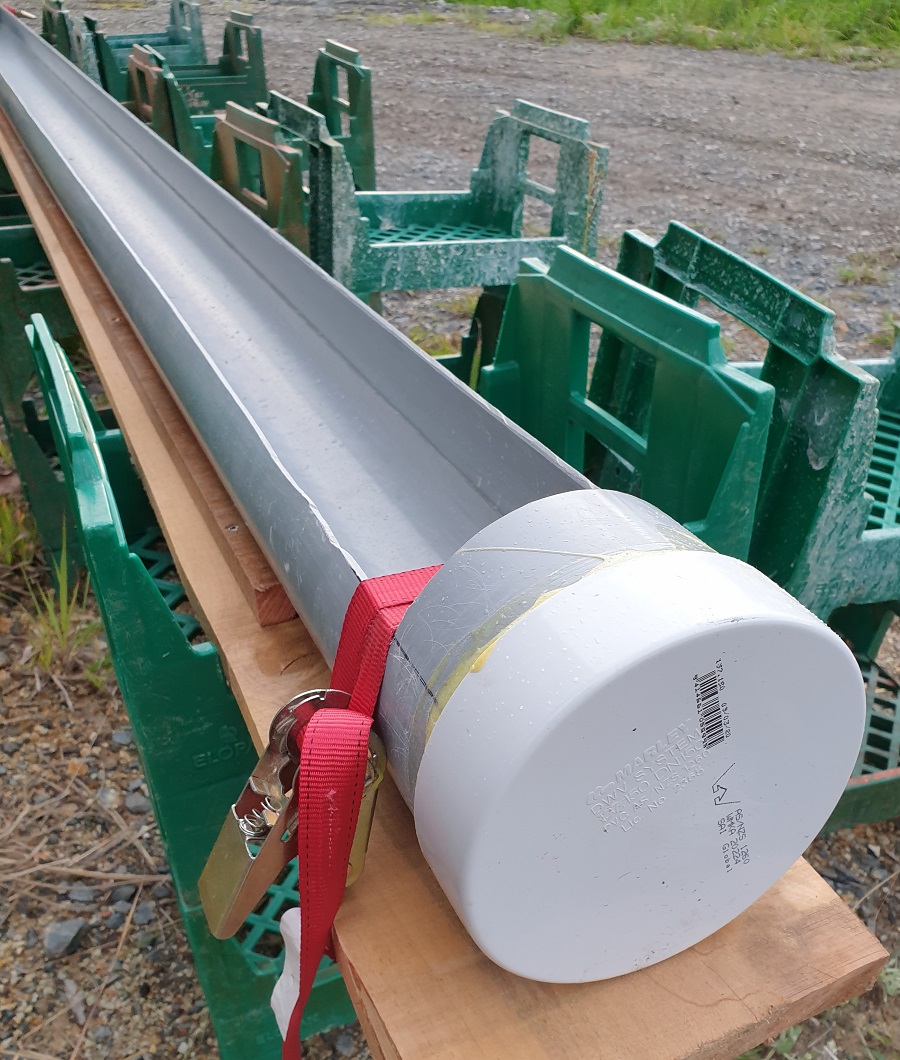
The boron dip vessel used for this trial.
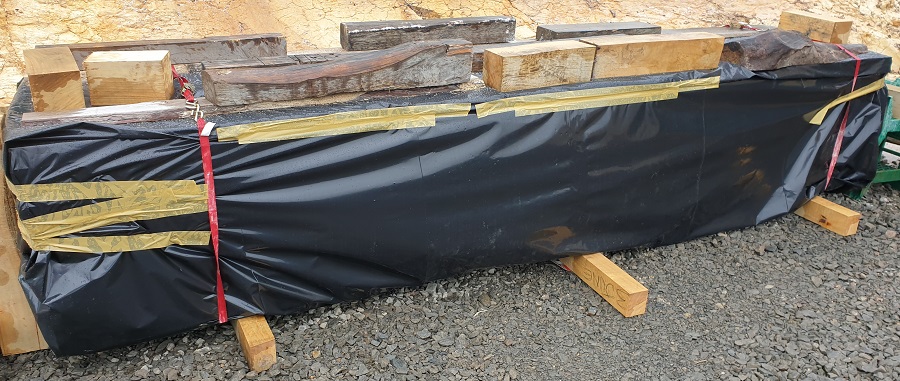
Boron-dipped Kawa timber block stacked and wrapped for diffusion.
2. Monoethanolamine based boron diffusion
TimTech BAX R-88 (88% boron dissolved in Monoethanolamine) was prepared by diluting with water to a 30% solution strength (30% BAX and 70% water).
50mm thickness freshly sawn timber was painted with the solution on two faces. The boards were block stacked and wrapped in polythene for three weeks. Boards were then fillet stacked and air dried.

Pink BAX solution painted on the two width faces of green-sawn 100mm x 50mm board before diffusion.
Methods of analysis, H1.2 boron
Boron retention and penetration tests were conducted by Independent Verification Services Ltd, Hamilton. Boron penetration was analysed using the Turmeric Acid test as per AS/NZS 1605.2:2018.
Because the heartwood sapwood boundary could not be determined using variamine blue RT (VBRT) salt solution with ammonia buffer as a staining test (AS/NZS 1605.1:2018), it was decided that full cross section analysis would be required to measure boron retention. Full cross section analysis assumes that the poplar being tested is 100% sapwood.
Boron retention samples were prepared using nitric acid micro digestion at 100°C for 60 minutes as per AWPA A7-12 (American Wood Protection Association 2012). Boron content was measured using Inductively Coupled Plasma - Optical Emission Spectrometry (ICP-OES), with correction for moisture as per AWPA A21-08 (American Wood Protection Association 2008). Boric Acid Equivalent (BAE) was calculated as elemental boron x 5.717.
Boron-treated Kawa Poplar Framing trials
Ten 90mm x 45mm boron treated air dry Kawa boards from the water-based boron diffusion method were supplied to Scion for their Framing Test, a H1.2 similar materials accelerated decay test as per AWPC Protocols (2015). Ten samples of untreated Kawa 90mm x 45mm air dry boards were also supplied, along with ten samples of 90mm x 45mm H1.2 radiata pine purchased from Carters Building Supplies, Waipapa, and another ten samples of untreated 90mm x 45mm aid dry radiata pine. Samples were 1m length and cut no closer than 20cm from the ends of treated boards.
The method of testing followed the "I" Frame Test procedure described in the AWPC protocols (2015) for Hazard Class H1.2.
Boron treated samples were analysed for boron levels before conducting the Framing Test. The Framing test was undertaken by Scion over a two year period.
Thermal modification
150mm x 50mm and 200mm x 50mm air-dried Kawa timber was supplied to Tunnicliffe Timber, Edgecumbe, for thermal modification. The wood was batch modified using the Thermowood 230 process in an open kiln. The Kawa poplar batch achieved two hours above 230º C, three hours above 225º C and four hours above 220º C.
See photographs of the thermally modified timber in this study here »
DMDHEU modification
Five 25mm thickness roughsawn Kawa boards were marked for sapwood and heartwood and provided to Mark Fortune, Business Unit Manager of TimTechChem (A Division Of Azelis NZ Ltd). These were added to a batch of 32mm thickness radiata pine being DMDHEU modified by TimTechChem.
Treatment schedule:
Initial vacuum of -85kPa held for 15 minutes once reached.
Working pressure of 1400 kPa held for 90 minutes once reached.
Final vacuum of -85kPa held for 15 minutes once reached.
The treatment schedule was common for all samples treated. This schedule is a standard Bethell (also known as the P4 process) schedule.
Uptakes of treating solution for the poplar (on the two samples that were measured) were:
549 l/m3
533 l/m3
% weight gains were not measured for the Poplar but you may be able to do some approximate calculations with what you have in hand now v’s some typical dried untread pieces, if available.
The modified boards were returned, and six sapwood samples and six heartwood samples were prepared from the five DMDHEU-modified Kawa boards. From one board three samples of sapwood and three samples of heartwood were taken, from another (mostly heartwood) board three heartwood samples were taken and from the other three (mostly sapwood) boards, one sample of sapwood was taken from each board. These were then tested by Michael Robertson of Scion for nitrogen content, which indicates DMDHEU content.
H3.2 CCA treated poplar decking
Two sample sets of H3.2 CCA treated poplar were tested for retention and penetration at IVS Labs in accordance with NZS 3640:2003:
- Ten boards of 25mm x 150mm air dried Kawa poplar, dressed to 20mm thickness (final shape and form) were included in a batch of 20mm thickness radiata pine CCA treated to H3.2 at Mt Pokaka Timber products, Kerikeri. A single radiata control board from the same batch was supplied with the H3.2 CCA treated poplar for preservative uptake comparison. A single sample from the middle of each board was submitted to IVS Labs for retention and penetration analysis for H3.2 CCA in accordance with NZS 3640:2003.
- Ruapehu sawmills supplied 24 samples from a batch of 140mm x 30mm dressed poplar that was CCA treated in final shape and form to H3.2 for exterior decking. This poplar was batch treated at Eastown timber products, Whanganui. Three boards were selected from the batch, and eight samples were cut from each of these boards at 30cm intervals. Samples 1e, 2e and 3e were taken from the end of each board to provide a comparison with the rest of the samples, which were away from the ends.
Boards 1 and 2 were visually typical in terms of appearance within the batch, and a third board was selected because it was unique, being much whiter than the other boards in the batch and from outer wood. Board 1 was selected to represent the mid-section of the log with equal quantities of heartwood and sapwood, and board 2 was selected to represent heartwood close to the core.
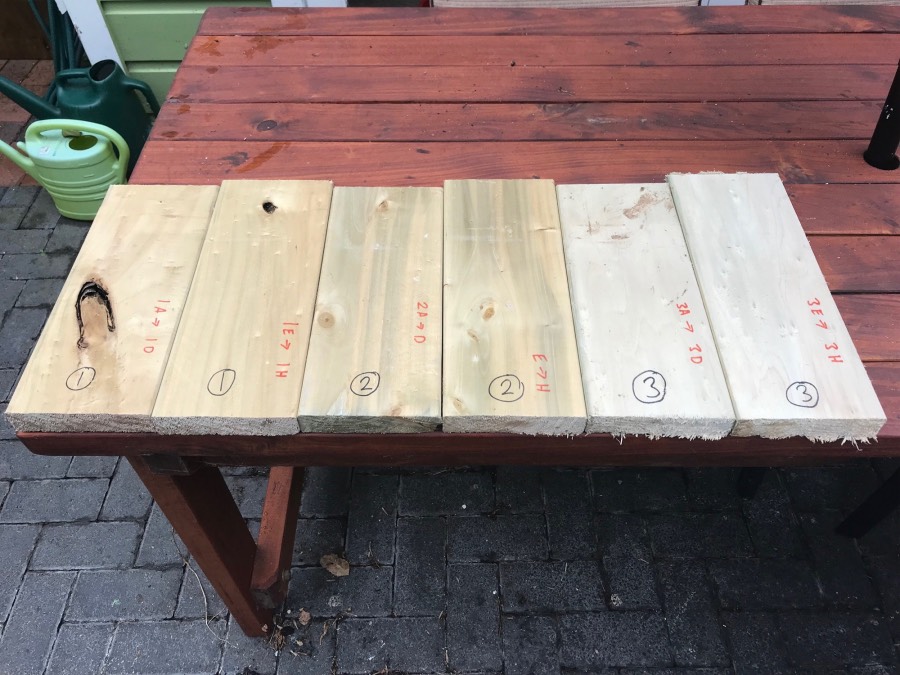
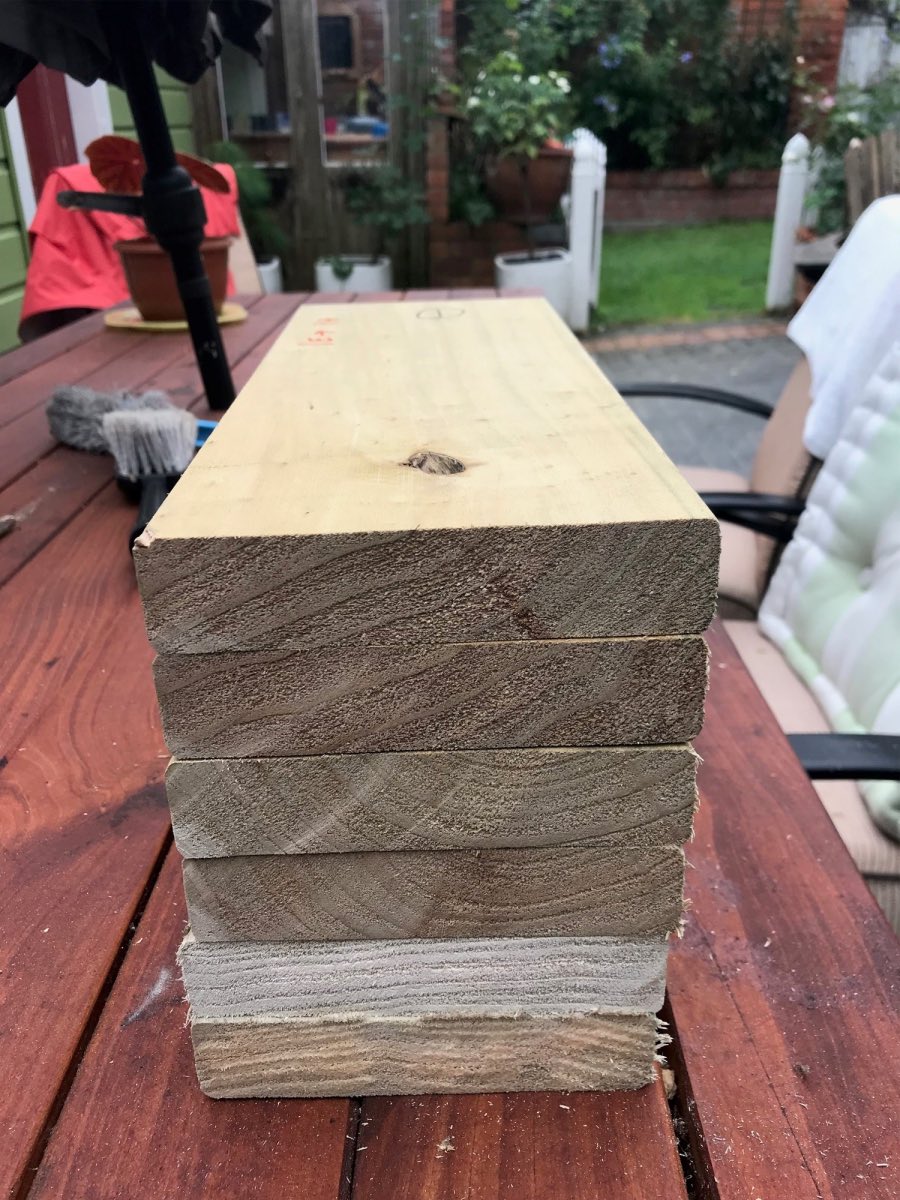
Poplar Cabin
A test cabin was constructed using Kawa poplar timber from this study. Framing and rafters were H1.2 boron treated Kawa poplar. Exterior cladding along with window and door joinery was thermally modified Kawa poplar, except one row of H3.2 MCA- treated Kawa weatherboards to also assess these for durability. This cabin was constructed to test thermally modified uncoated exterior cladding, corner boxes, fascia and exterior joinery and surrounds for durability performance over fifteen years, as per Clause B2 of the building code (B2VM1). The cladding, corner boxes, fascia, window joinery, window sills, window surrounds and door joinery was not coated.
The laminated beam, ceiling sarking and flooring were assembled from untreated dry Kawa poplar timber.
See photographs of the poplar cabin being constructed here »
Poplar floor
150mm x 25mm Kawa was dressed into tongue and groove flooring which was installed over joists using secret nails. The moisture content at installation averaged 13%, varying from 11% to 15%, as measured using a portable moisture meter.
1.5 litres of Gemrez brand clear two pot epoxy - LR 2:1 GP - Laminating Resin was purchased from New Zealand Fibreglass Ltd, trading as NZFG Composite Supplies, St Johns, Auckland. One litre of resin was mixed with 0.5 l hardener, then mixed with 1.5 litres of denatured ethanol (99%) to make 3 litres of floor coating. This was rolled on to the cabin floor and as it soaked in, was repeatedly rolled until it stopped soaking into the floor, but before the resin started to gel. The resin started to gel about 30 minutes after mixing. Two litres of epoxy floor coating was used (the cabin floor is approximately ten square metres) which provided a fairly thick coating that set evenly. The epoxy was left for a week to cure, then lightly sanded before applying four light coats of water-based polyurethane (Intergrain UltraFloor satin). This polyurethane was selected because it was advertised as including UV absorbers and "will not darken or yellow". Approximately 2 litres of polyurethane were applied in 4 coats, each an hour apart.
Structural poplar
The water-based boron diffusion H1.2 treated poplar was dressed to 90mm x 45mm and 140mm x 45mm and utilised for framing the cabin. Some 140mm x 45mm Kawa was selected for rafters. Radiata pine 90mm x 45mm H1.2 framing was used where long lengths were required and as a durability control.
The beam was constructed from 75mm x 25mm untreated air-dry Kawa poplar, finger-jointed and screw + glue laminated. Gorilla polyurethane glue was used for finger joints and faces. The beam was well oversized, noting this was not a test of the construction nor sizing for the span, but to display the appearance qualities of poplar in a structural application. Both ends were coated with two coats of BAX 88% boron before enclosing.
Poplar sarking
200mm x 25mm Kawa poplar was dressed as T G & V panelling. The moisture content at installation averaged 13%, varying from 11% to 15%. Panelling was nailed onto rafters after sanding, then coated with water-based polyurethane (Resene Aquaclear satin).
Photographs and further detail on methods for constructing the poplar cabin are here »
Thermally modified poplar weatherboards
Weatherboards were prepared from nominal 150mm x 50mm and 200mm x 50mm thermally modified Kawa poplar. These were first ripped through the centre with a 4mm kerf bandsaw into 150mm x 23mm and 200mm x 23mm boards with a "bandsawn face". These were then profiled into shiplap weatherboards that retained the bandsawn face. Holes and voids were then filled with Sika brand modified silicon (MS). Methylated spirits was used to remove surplus MS product from the face and back of the board before it dried. All visible voids were filled to create a leak proof cladding product. The ex 150mm and ex 200mm weatherboards were installed in the poplar cabin.
MCA-treated poplar weatherboards
150mm x 25mm sawn Kawa poplar clearwood boards were profiled into shiplap weatherboards, then added to a batch of 25mm sawn radiata pine being treated with Micronised Copper Azoles to H3.2 at Mt Pokaka Timber Products, Kerikeri. The resulting boards were air dried under cover for 4 weeks before installing in the poplar cabin. A single layer of MCA treated weatherboards were installed in all four walls of the cabin, the fifth weatherboard up from the bottom.
The MCA-treated weatherboards (treated in final shape and form) and a single radiata control from the same treatment batch were submitted to IVS labs for preservative testing.
Thermally modified poplar window and door joinery
100mm x 50mm thermally modified Kawa poplar was square dressed and two boards laminated with polyurethane glue (Rectavit Structan Polyurethane) into 95mm x 95mm lengths of timber. These were machined into profiles, then assembled into windows and doors by Sam Burgess of Optimal Windows, Takou Bay, Kerikeri. Interior surfaces were oiled but exterior surfaces received no coating.
Disclaimer: The opinions and information provided in this report have been provided in good faith and on the basis that every endeavour has been made to be accurate and not misleading and to exercise reasonable care, skill and judgement in providing such opinions and information. The Author and NZFFA will not be responsible if information is inaccurate or not up to date, nor will we be responsible if you use or rely on the information in any way.

 Farm Forestry New Zealand
Farm Forestry New Zealand